Sustainable snow and ice control should go hand-in-hand with ecological stewardship
Anyone living in a snowbelt state, where pothole dodging has become a survival skill, realizes we have serious issues with our roads and bridges. And what the public is becoming increasingly aware of is that winter maintenance salting is largely the cause. Less obvious, but of equal concern, is the escalating damage winter salting is having on water resources and the ecosystems they support.
Beyond someone’s individual concerns with road conditions and environmental contamination, this is a problem that truly affects everyone. In fact, current estimates place the cost to taxpayers at a minimum of $1,800 per ton of salt spread to repair the damage caused by winter salting. Multiply that by the 20 million tons of road salt used annually in the U.S. (a number that is rapidly increasing) and it is clear that this trend, if left unchecked, will continue to deliver sizable economic consequences, not to mention the environmental impacts that can lead to wide-ranging public health concerns.
Troubling Data
Over the past decade, the impacts from road salt use have been the subject of many nationwide studies, including those published by The Cary Institute, University of Wisconsin-Madison, USGS, Clear Roads, and the University of Montana’s Western Transportation Institute. Among the findings of these studies is that chloride levels in urban affected inland lakes and rivers have more than doubled in two decades across the Snowbelt.
Monitoring states are already reporting significant disruption in the balance of critical ecosystems resulting from these elevated chloride levels. This has come in the form of increased algae blooms, the growing presence of invasive species and fish kill. In several states and Ontario, officials are finding well water that has become irrevocably compromised and warn that cities with aging infrastructures that pull their drinking water from inland sources are at risk of similar circumstances to what was seen in Flint, Michigan if system upgrades aren’t made and salting practices continue on their current paths.
Taking Action
As a result of these environmental concerns, the issue of road salt use is increasingly on the radar of public officials and starting to drive initiatives and regulations nationwide. For instance, in Chicago there is a mandate to reduce the chlorides entering the Chicago Area Waterways System (CAWS) and to enforce the Illinois EPA Water Criteria for chlorides year round. This will require a broad regional partnership of municipalities, industry and the public to implement sustainable salt best management practices. A coalition of this nature is currently underway in the Lake George Watershed in New York to reduce road salt impacts and protect its $2 billion tourist industry.
Other programs, like Wisconsin Salt Wise, Vermont Better Roads, Ontario’s Smart About Salt and Minnesota’s Winter Maintenance Assessment tool (WMAt), seek to teach sustainable salt best management practices, not only to municipal and commercial service providers, but also the public that uses their services. In New Hampshire, the approach has been to pass legislation offering liability protection to service providers who obtain Green SnowPro Certification. Whereas in other areas of the country, winter maintenance operations are increasingly facing fines for the improper storage and application of road salt.
Though many assume highway and road maintenance to be the major cause, the fact is the greatest uptick in salt usage has been for the servicing of parking lots, which now accounts for more than 50 percent of the salt loading to the environment. In 2016, this finding prompted the Snow and Ice Management Association (SIMA) to adopt sustainability as a core value and to caution its members to anticipate regulation.
Brine Time
The current industry atmosphere has created a conundrum for winter maintenance providers. On the one hand, there is increased public pressure to protect the environment, but there is also increasing demand for better road safety...the one requires less road salt use and the other ostensibly requires more. This leaves winter maintenance service providers caught in the middle, with plenty of need for their services, and plenty of potential liability for providing them. Fortunately, the answer may not be that complicated.
The use of liquid snow and ice control materials (i.e. salt brine) can mitigate these risks by preserving optimal surface driving conditions, but with less cost and significantly less salt than traditional deicing methods. Because less salt is used, liquids are less damaging to infrastructure and the environment, as well as being a more sustainable solution for budget strapped municipalities and commercial businesses trying to turn a profit. Liquids are also very versatile, with the ability to be effectively used before, during and after a winter event.
Furthermore, liquids utilize much more precise material application systems that substantially reduce the amount of material that is broadcast, plowed or blown off the target surface into surrounding storm drains or green spaces. And because liquids dry on the surface, unlike granular salt and sand left behind after spreading, their use results in much less labor/cost for cleanup.
Anti-icing
Anti-icing is an industry game changing best-management practice focused on prevention instead of reaction. This approach can be employed at any point in the order of operations, as long as bonded ice/hard pack is not present. Prior to a winter event, anti-icing involves a light direct liquid application (DLA) of brine (30 to 50 gal/lm) to the pavement surface. This can be done days prior to the event, as long as rain is not expected. After the application, the brine settles into the pores of the surface and dries. What remains is a protective barrier of fine salt that insulates the pavement and prevents the formation of ice. If anti-icing measures are properly executed, and plowing measures properly timed, plowing will be much more effective. Because of this, anti-icing has been demonstrated to preserve optimal pavement conditions and maintain greater surface friction longer than traditional salting/sanding.
Anti-icing can be likened to the benefits of preventive medicine. There is hard evidence supporting that investing money to keep patients healthy is substantially more cost-effective (and profitable) than trying to make them better after they are already sick. A similar premise exists with anti-icing.
Pretreating the driving surface with brine before a storm keeps it free of bonded ice, which is safer and more cost-effective than trying to remove bonded ice/hard pack after it has formed.
Put into numbers, studies have shown, and field data confirms, that preventive anti-icing utilizes as little as one-fourth of the material and one-tenth of the overall cost (labor, equipment and material) of traditional deicing.
Another tactic is post-treating with liquids to extend anti-icing efforts. This can be an effective alternative to spreading granular salt when conditions warrant, preventive measures have been successful, or a minimal amount of unbonded precipitation exists on the surface. Utilizing slightly higher application rates than for pretreating, DLA post treatment is simple and cost-effective. Clear Roads has conducted nationwide field research on During Storm DLA (September 2010) and Liquid-only Plow Routes (June 2018) highlighting the benefits of post treatment. Both studies are available on the Clear Roads website: www.clearroads.org.
Deicing with Pre-wet Granular Salt
If it is not possible to stay ahead of the storm and deicing is required, brine can still be an effective tool. Spreading granular salt that is pre-wet with brine (8 to 20 gal/ton) as it is applied to the pavement or using salt slurry spreader technology (60 to 90 gal/ton) significantly outperforms dry salting on many levels. Pre-wetting is an ideal entry point when getting into liquid applications, requiring little change to operations and minimal equipment investment.
In the 10-15 minutes following application to the surface, 80% of the melting action of pre-wet salt is coming from the brine liquid. During that time, the dry material is jumpstarted and brining faster to accelerate results. In addition to providing substantially faster melting action, pre-wetting also helps keep salt on the driving surface.
According to the Michigan DOT’s 2012 Bounce and Scatter study,
pre-wetting keeps 30% more salt on the intended surface.
Deicing with DLA
DLA for deicing bonded ice or hardpack is not a widely practiced or recommended tactic. Though expert practitioners have ventured into this approach, DLA for deicing purposes requires significant experience using liquids and the use of tactics/equipment capable of penetrating ice/hard pack and forcing the brine down to the driving surface. Caution is recommended before engaging in this approach because without the proper knowledge and equipment, one could create a greater hazard than already exists – effectively turning a slippery road into an ice rink.
The Best Brine
The best type of brine is entirely dependent on the unique needs of the user. However, according to the Salt Institute, salt brine is the most environmentally safe and cost-effective choice at pavement temperatures above 15-degrees Fahrenheit. And, for a majority of the winter season throughout the Snowbelt, pavement temperatures remain on average above that threshold.
When low temperature performance is required, the more costly calcium and magnesium chloride brines, as well as proprietary products that use these materials as a base, are often preferred. Agricultural byproducts are additives that can enhance brine performance. According to studies by Pacific Northwest Snowfighters (PNS) and Clear Roads, while these additives alone don’t demonstrate significant melting properties, they can help brine adhere to the pavement longer, providing a greater residual effect, and they can also reduce the corrosivity of brine to mild steel. Some agricultural additives have also been demonstrated to enable the brine to work at lower temperatures by inhibiting the brine’s freeze point.
Commercial service providers in Minnesota and Illinois have reported achieving desired results for their zero tolerance accounts at pavement temperatures below 0-degrees Fahrenheit by blending salt brine with calcium/ag byproducts at up to 30-percent of the mixture. Many state DOTs and municipal highway departments likewise report achieving optimal road safety performance results at low temperatures utilizing such blends.
There is no one answer to the type, timing and amount of brine to use. For each agency or service provider, the best choice depends on a host of variables, including typical winter conditions in the area, supply availability, material costs, volume needs, storage capacity, performance goals and operator experience.
While liquid strategies are nothing new and have been used by highway departments for a couple decades, they have failed to achieve widespread recognition in the industry until relatively recently – mainly due to the low cost and ready availability of salt. But things are changing. Volatility in the supply and cost of salt has severely constrained winter maintenance providers in recent years. Turning salt into brine provides sustainable – cost effective solutions that can substantially reduce salt usage, and it can do it while optimizing highway safety and mitigating the damaging impacts of salt on infrastructure and the environment in ways traditional methods of deicing can’t. Simply put, liquids have become irreplaceable tools for the salt-smart snowfighter.
Pam Buckley
Sustainability Manager, Douglas Dynamics LLC.
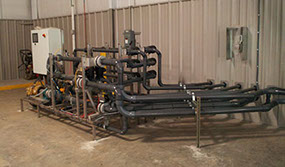
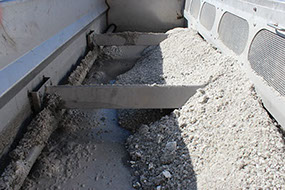
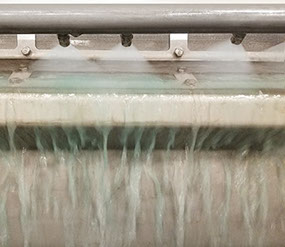

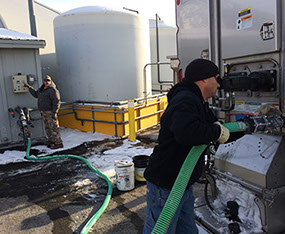
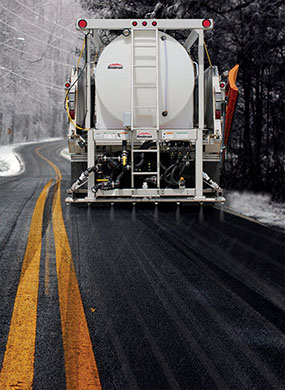

BrineXtreme brine makers easily and consistently produce salt brine capable of deicing down to -6° F.
Regular seasonal use of salt brine can decrease overall salt consumption up to 30%.
For more information on the complete line of Henderson Products Snow and Ice Control Equipment, call Henderson Products at 800-359-4970.
Copyright © 2018 Henderson Products, Inc., a division of Douglas Dynamics, Inc. All Rights Reserved.
About Us
Career Opportunities
Privacy Policy
